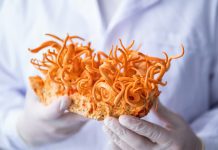
Vital for maintaining health, the endocannabinoid system is found in both animals and humans.
The two cannabinoid receptors, CB1 and CB2, belong to the so-called endocannabinoid system. This refers to a signalling system in the body that regulates biological processes such as metabolism, pain sensation, neuronal activity, immune function, and more. It has been shown that the cannabinoid receptors can be targeted to alleviate certain pathological conditions, including chronic pain.
The brain contains about 100 billion nerve cells that are constantly communicating with one another at specialised junctions called synapses. Nerve cells possess extensions called axons, which send signals to synapses, and dendrites, which receive information from synapses.
At the synapse, the electrical ‘firing’ of a nerve cell causes the release of chemicals called neurotransmitters from the presynaptic terminals of its axon. These neurotransmitters cross the synapse and pass on the signal by binding to receptors at postsynaptic sites on the dendrites of the next nerve cell.
Understanding cannabinoid receptors
Researchers at the University of Bristol have made progress in understanding how cannabinoid receptors (CB1Rs) are controlled in the brain.
CB1Rs, the proteins that detect the active components of cannabis, help control information flow in the brain by binding molecules made in the brain called endocannabinoids, which influence brain functions such as pain, appetite, mood and memory.
Unusually, endocannabinoid signalling goes in the reverse direction compared to most other neurotransmitters.
This reverse or ‘retrograde’ signalling that activates presynaptic CB1Rs ‘dampens down’ presynaptic release of other neurotransmitters resulting in a slowing of brain activity. Moreover, the active components of cannabis bind to CB1Rs in a similar manner to endocannabinoids, resulting in the ‘mellow’ sensation caused by the use of cannabis.
For CB1Rs to regulate brain function properly, it is essential that they are sent to the right place on the surface of an axon. However, very little is known about exactly how this occurs. The researchers at Bristol showed that a specific part of the CB1R protein plays a key role in the getting CB1R into axons.
By tracking newly made CB1Rs in nerve cells grown in a dish they found that a short region of CB1R is crucial for sending CB1R to the axon and preventing it from going to the dendrites – the segments of the neuron that receive stimulation in order for cells to become active.
They also discovered that this region stabilises CB1R at the surface of the axon, making it more available to receive signals from endocannabinoids.
Jeremy Henley, Professor of Molecular Neuroscience in Bristol’s School of Biochemistry, said: “In recent years there has been tremendous interest in – and controversy about – activation of CB1R by medical cannabis.
“It is becoming increasingly apparent that activation of CB1Rs could be therapeutically useful for a wide range of diseases such as chronic pain, epilepsy, or multiple sclerosis. Understanding the fundamental properties of CB1R is an important basis for future studies exploring the efficacy and optimisation of these targeted approaches.”
It is hoped that this increased understanding of how CB1Rs behave in nerve cells will pave the way for future studies aimed at examining the possible medical uses of cannabis, or other drugs that target CB1Rs, in treating a wide range of disorders.
Yin and yang
Further research has been conducted by a Chinese research team who joined forces with Russian and US biologists to obtain the crystal structure of the human type 2 cannabinoid receptor.
Their findings will help develop drugs against inflammatory, neurodegenerative, and other diseases. The authors of the paper in Cell compare the newly discovered structure to that of the type 1 cannabinoid receptor, deeming the two receptors, CB1 and CB2, to be the “yin and yang” of the human endocannabinoid system.
While the CB1 receptors are mostly found in the nervous system and are responsible for psychoactive effects, the CB2 receptors are predominantly present in the immune system. Studies indicate that CB2 is a promising target for immunotherapy, as well as treating inflammatory and neuropathic pain, and neurodegenerative diseases. It has also been shown that molecules blocking CB2 can reduce tumour growth.
To effectively treat pathological conditions, drugs need to specifically target CB1 or CB2. However, the two receptors are very much alike. The amino acid sequences that encode them are 44% identical. So, developing a selective medicine requires knowing the structure of both targets in great detail. Unlike CB1, the structure of CB2 has remained unknown up until now.
Crystal structure of receptor
To identify the shape of an individual molecule, researchers make a crystal from many such molecules. When arranged in this highly ordered way, the molecules can be exposed to X-rays, revealing their structure.
The team made a crystal from CB2 receptors bound to molecules blocking this receptor, which are potential drug candidates. That way, the X-ray analysis allowed the team to see both the structure of CB2 and how it connects to the blocking molecule, or antagonist.
However, receptors are unstable proteins by nature. To study them, they need to be modified using gene engineering. This involves introducing mutations that make the protein stable without changing its structure or function.
Smarter drugs
The researchers contrasted the structure of CB2 with that of CB1. They concluded that substances activating one of the receptors can actually weaken or inhibit the other, and vice versa. This opens up a possibility not just for drugs that target exclusively one receptor, but those that affect both receptors, but in different ways.
Study co-author Petr Popov said: “Every G protein-coupled receptor structure that is discovered has prospects for rational design of more efficient drugs.
“Now that the structures of both cannabinoid receptors are known, we can design selective compounds targeting only one of the receptors, as well as agents with a desired polypharmacological profile targeting both receptors at once.”
Paradoxical pro-inflammatory effect
One study led by the Neuropharmacology Laboratory at Pompeu Fabra University (UPF) shows that increasing endocannabinoids in the brain may cause inflammation in specific brain areas such as the cerebellum, which is associated with problems of fine motor coordination.
The results of the study in mice are contrary to what had been observed to date in other areas of the brain where endocannabinoids play an anti-inflammatory role.
The endocannabinoid system is involved in many physiological brain functions, including motor co-ordination. This system is modulated by cannabinoid acquired both externally, as would be tetrahydrocannabinol (THC) from the plant cannabis sativa, and endogenously, naturally produced by the body and known as endocannabinoids.
One of the beneficial effects of cannabinoids are their anti-inflammatory properties, which can be useful for treating inflammatory diseases that develop in the brain. To date an increase in the main endocannabinoids – 2-arachidonoylglycerol (2AG) and anandamide – had been seen to have an anti-inflammatory role in the brain in general, and the same results have also been observed by focussing the experiments in specific areas such as the hippocampus.
The team’s results show that in the cerebellum the opposite occurs from in the rest of the brain because increasing endocannabinoids increases inflammation, and this leads to motor co-ordination problems in the rodents.
To modulate the levels of endocannabinoids in the mice, the scientists use degradation inhibitors thus causing the latter to accumulate. They specifically inhibited the enzyme monoacylglycerol lipase (MAGL), which is responsible for degrading endocannabinoid 2AG.
Sensitivity of the cerebellum
Sara Martínez-Torres, first author of the article, said: “Our experiments show that the pharmacological or genetic inhibition of MAGL results in significant deficits in motor co-ordination and increases inflammation.
“We have seen that this inflammation in the cerebellum is caused by an increase in the COX2 enzyme, which is induced during inflammatory processes and produces proinflammatory mediators.”
The molecular alterations were not observed in the hippocampus, which points to a particular sensitivity of the cerebellum.
Co-author Andrés Ozaita said: “The differential response between the cerebellum and the hippocampus may arise from the alternative metabolism of 2-AG accumulated in the two brain areas.”
The study reveals the sensitivity of the cerebellum to changes in the signalling of the endocannabinoid system, compared with other areas of the brain like the hippocampus. It also highlights a possible disadvantage of strategies aimed at inhibiting MAGL activity for treating inflammatory disorders.
The endocannabinoid system
The endocannabinoid system was discovered in 1992 by scientist Dr Lumir Hanus and researcher Dr William Devane and is believed to maintain balance within the body. There has been much research done into how it works since then, however, researchers are still learning and understanding more every day.
All animals, except insects, have an endocannabinoid system and endocannabinoid system firing can also be induced by exercise and activity.
The system offers potential as a drug target for a number of different diseases and conditions.


















